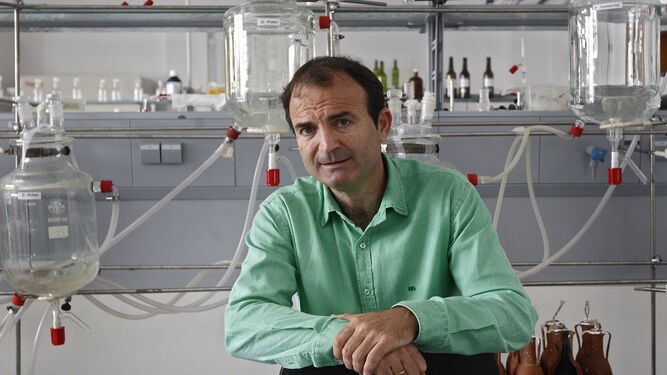Pau Sancho Galán, Antonio Amores Arrocha, Víctor Palacios and Ana Jiménez-Cantizano.
Department of Chemical Engineering and Food Technology, Vegetal Production Area, University of Cadiz. Agrifood Campus of International Excellence (ceiA3), IVAGRO, Puerto Real, Cádiz, Spain.
The vine (Vitis vinifera L.) is one of the most widely cultivated species worldwide. Around 12500 varieties have been registered in the Vitis International Variety Catalogue (VIVC) (Marsal et al., 2019). However, based on their DNA profiles, the number of vine varieties is estimated to be around 5000, many of them closely related (Jiménez-Cantizano et al., 2018). Each grape variety is identified with a genotype, phenotype and behaviour that makes it unique. In this sense, the different varieties can constitute a phytogenetic resource of interest to select those that best adapt to the conditions imposed by climate change. Wine grapes possess tremendous diversity in traits that affect responses to climate, such as phenology and drought tolerance. Yet little of this diversity is exploited. Instead many countries plant 70–90% of total hectares with the same 12 varieties, representing 1% of total diversity (Wolkovich et al., 2018). In general, climate change is causing modifications in the development of wine grapes, bringing forward the harvest by 10 to 24 days in the last 30-50 years (Mira de Orduña, 2010) and increasing excessively the ripening of the grapes. Therefore, due to the effects associated with climate change, musts are currently obtained with potentially high alcoholic degrees, higher pH, lower acidity and significant nutritional deficiencies which generally translate into low levels of easily assimilated nitrogen.
One of the most current aspects that the OIV is facing in the medium to short term is the selection and improvement of new varieties for adaptation to climate change (de la Fuente, 2018). There are numerous works related to the genetic and morphological characterisation of native vine varieties using Simple Sequence Repeat (SSR) or microsatellite molecular markers and ampelographic descriptors (Marsal et al., 2019). However, these works do not include data on the physicochemical composition of their musts, which are decisive for knowing their oenological potential, the adaptation of these varieties to the conditions of the agro-climatic zone.
With the aim of searching for vine varieties or somatic variants better adapted to the conditions imposed by climate change in an area with a hot climate such as SW Andalusia, the Plant Production area of the University of Cadiz is working on the genetic identification, ampelographic description and physical-chemical characterisation of the musts of vine varieties and somatic variants autochthonous of the Jerez area.
The genetic identification of different autochthonous varieties such as Uva Rey, Castellano and Cañocazo, with 22 SSR microsatellites, has provided new genetic information to the Vitis International Variety Catalogue (VIVC), as well as confirming the synonymy between the Uva Rey and Mantúo de Pilas varieties under their prime name De Rey (Sancho-Galán et al., 2019). In turn, morphological analysis of these varieties during two campaigns has identified varieties with greater hairiness in their photosynthetic organs and, therefore, better adaptation to drought conditions because a greater presence of hairs or trichomes can prevent water evaporation in situations of high temperatures (Gago et al., 2016). On the other hand, different somatic variants (Palomino Pelusón, Palomino Gacho and Palomino de Jerez, Figure 1) of the main variety cultivated in Andalusia, Palomino Fino, have also been studied. The morphological study of the different somatic variants has made it possible to find, as in the case of the autochthonous varieties, some qualities that could make them a plant material better adapted to the increase of temperature and decrease of precipitation due to climate change (Sancho-Galán et al., 2020a).

Significant differences have been observed between the autochthonous varieties, and different somatic variants with respect to Palomino Fino variety. The physical-chemical study of the musts has shown how some of the autochthonous varieties studied as Uva Rey or Castellano, in a preliminary way, could be better adapted to the current situation of climate change (Sancho-Galán et al., 2020b). These varieties had a longer phenological cycle and, therefore, would allow a slower ripening of the grapes, thus achieving a better technological and phenolic ripening. All of them have exhibited an adequate physicochemical composition to produce quality white wines. For all of the above reasons, these local varieties and somatic variants should be considered suitable for cultivation in areas with warmer and drier climates, such as Andalusia (Spain). Also, the use of grapes from somatic variants can be a viable and natural alternative for the production of quality wines in warm climate areas. Additionally, promoting the cultivation of the somatic variants could contribute to preventing the loss of Palomino Fino intraspecific variability.
See all at: https://www.mdpi.com/2073-4395/10/5/654/htm

Pau Sancho Galán
Antonio Amores-Arrocha 
Victor Palacios 
Ana Jiménez Cantizano 

Pau Sancho Galán is a PhD Student in the research group PAIDI AGR-203 at the University of Cadiz. BSc in Oenology and MSc in Agri-food production focuses his research in looking for strategies and alternatives for wine elaboration in warm climate regions under climate change conditions. His results have been published in 7 research articles in high impact journals, as well as he has attended as a speaker at various international conferences.
Professor Antonio Amores-Arrocha (PhD) is researcher in PAIDI AGR-203 research group at the University of Cadiz and member of the Instituto de Investigación Vitivinicola y Agroalimentaria (IVAGRO). His research is focused mainly on studying bee pollen as oenological tool as activator and nutrient for alcoholic fermentation yeasts, autochthonous grape varieties and its oenological potential and technical diversification to winemaking. Nowadays, he develops educational teaching work in the degree in Oenology and the Master’s degree in Agri-food as well as research dissemination activities within the university environment.
Professor Victor Palacios is associate professor of Food Technology at the University of Cadiz. He has a degree in Chemical Sciences with a specialization in Industrial Fermentation and Enology. He holds a PhD in Chemical Engineering from the University of Cadiz. He currently occupies the position of principal investigator of the AGR-203 Engineering and Food Technology research group. His research focuses on the process of biological ageing under flor velum, the study of natural activators for alcoholic fermentation and the viticultural potential of grape varieties and oenological processes to counteract climate change effects .
Professor Ana Jiménez Cantizano graduated in Biology at the University of of Seville and Oenology at the University of Cadiz. She carried out her PhD thesis entitled “Molecular characterization of grape varieties preserved in the Rancho de la Merced Grapevine Germoplasm Bank” in the IFAPA Research Center Rancho de la Merced (Jerez, Spain). After her PhD she worked as a teacher in a workshop school of viticulture an oenology during two years. Currently she is lecturer in the Vegetal Production Area at Univesity of Cadiz and carries out her research in PAIDI AGR-203 research group and member of the Instituto de Investigación Vitivinicola y Agroalimentaria (IVAGRO). She has participated in 18 research projects/contracts in the field of viticulture and oenology.


Dear Dr. Paula Silva.
Thank you very much for contacting us and giving us the opportunity to be a part of this blog to spread the knowledge about everything related to viticulture and oenology.
Along with the link you have provided at the end of the article, I am including in this commentary other bibliographic sources published in open access for anyone interested to consult.
Identification and characterization of white grape varieties: https://www.mdpi.com/2073-4395/10/2/205
Uva Rey cultivar: https://www.mdpi.com/2073-4395/9/9/563
Greetings!
Pau Sancho-Galán.
Dear Pau
Thanks so much for sharing your science and for your collaboration with Science & Wine Blog.